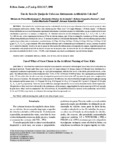Por favor, use este identificador para citar o enlazar este ítem:
http://www.alice.cnptia.embrapa.br/alice/handle/doc/515043| Título: | Uso do soro de queijo de cabra no aleitamento artificial de cabritos. |
| Autor: | MONTENEGRO, M. de P.  AZEVEDO, A. R. de   BARROS, N. N.   PIMENTEL, J. C. M.   ALVES, A. A.   |
| Afiliación: | Miriam de Paiva Montenegro, EMATERCE - Fortaleza, CE; Abelardo Ribeiro de Azevedo, Universidade Federal do Ceará (UFC) - Fortaleza, CE; Nelson Nogueira Barros, CNPC; José Carlos Machado Pimentel, CNPAT; Arnaud Azevêdo Alves, UFPI - Teresina, PI. |
| Año: | 1998 |
| Referencia: | Revista Brasileira de Zootecnia, Viçosa, MG, v. 27, n. 6, p. 1212-1217, 1998. |
| Descripción: | Resumo: Este trabalho foi conduzido para avaliar a substituiçao do leite de vaca por diferentes níveis de soro de queijo de cabra no aleitamento artificial de cabritos. Vinte e oito cabritos machos "three cross" (1/2 Anglo Nubiano + 114 Parda Alpina + 1/4 Moxotó) constituíram as parcelas e as semanas, as subparcelas. Os diferentes níveis de soro nos tratamentos foram: T1 = 0; T2 = 20; T3 = 40 e T4 = 60% de soro. A fase experimental iniciou no 35º dia de vida dos animais, após 10 dias de adaptaçao e terminou aos 84 dias, quando os cabritos foram abatidos para avaliaçao da carcaça. 0 consumo de matéria seca foi medido diariamente. Nao se obsevou diferença para peso final e ganho de peso diário entre os tratamentos e as médias foram: 12,79 kge 144,43 g; 13,02kge 145,81g; 12,21 kge 130,52g; e 12,33 kge 147,84 g, para T1' T2, T3 e T4, respectivamente. Nao houve também diferença entre os tratamentos para rendimento de carcaça, consumo de matéria seca e conversao alimentar. Os níveis de soro de queijo de cabra usados nao influenciaram o desempenho dos animais, sugerindo que pode ser recomendada a substituiçao de até 60% do leite de vaca por soro de queijo de cabra. Os níveis de soro 20, 40 e 60% possibilitaram decréscimo nos custos de produçao de 30,63; 41,44; e 79,28%, respectivamente, em relaçao ao aleitamento com leite bovino integral. [Use of whey of goat cheese in the artificial nursing of goat kids]. Abstract: This work was conducted to study the replacement of cow milk for different goat cheese whey levels in the artificial nursing of goat kids. Twenty-eight ?three-cross? male kids (1/2 Anglo-nubian+1/4 German Alpine+1/4 Moxotó) were distributed to a completely randomized experimental design, in a split plot arrangement, with the four levels as the whole plot and the weeks, as the plots. The different whey levels in the treatments were: T1=0, T2=20, T3=40 and T4=60% of whey. The experimental period initiated at the 35th day of the kids life after a ten days of adaptation period and finished at the 84th day when the goats were slaughtered for their carcasses evaluation. The dry matter were daily measured. No difference was observed for final weight and daily weight gain among the treatments and the means were: 12.79 kg and 144.43 g; 13.02 kg and 145.81 g; 12.21 kg and 130.52 g and 12.33 kg and 147.84 g for T1, T 2, T3 and T4, respectively. There was also no difference among treatments for carcass yield, dry matter intake and feed:gain ratio. The goat cheese whey used levels did not affect the performance of the animals, suggesting that the replacement up to 60 % of cow milk by goat cheese whey can be recommended. The levels of whey 20, 40 and 60% resulted in a decrease in the production cost of 30.63; 41.44; and 79.28%, respectively, in relation to the nursing with of integral milk cow. |
| Thesagro: | Caprino Aleitamento artificial cabrito Leite de cabra |
| NAL Thesaurus: | Goats Cheese whey Goat milk Breast feeding Suckling |
| Palabras clave: | Leite de vaca Milk of cow Kids Soro de queijo Cow milk |
| Tipo de Material: | Artigo de periódico |
| Acceso: | openAccess |
| Aparece en las colecciones: | Artigo em periódico indexado (CNPC)  |
Ficheros en este ítem:
| Fichero | Descripción | Tamaño | Formato | |
|---|---|---|---|---|
| APIUsodosoro.pdf | 38.37 kB | Adobe PDF |  Visualizar/Abrir |









